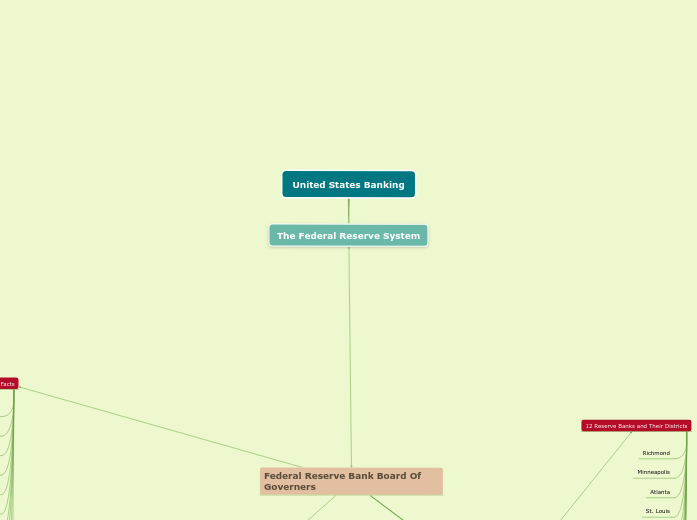United States Banking
The Federal Reserve System
Federal Reserve Bank Board Of Governers
Facts
Members Appointed By President and Confirmed By Senate
Serve 14 Year Terms, staggered
Chairman and Vice-Chairman Serve 4 year terms
Go to All FOMC Meetings and Have Majority Vote
Oversee Reserve Banks and Approve Directors
Located in Washington D.C.
Sets Reserve Requirements
Sets Margin Requirements
Approves Discount Rate
(interest rate at which Banks
can borrow from Federal Reserve Banks
in their district)
3 Different Version of the Discount Rate
1. Primary Credit Rate
2. Secondary Credit Rate
3. Seasonal Credit Rate
Set the interest rate on required reserves (interest that federal reserve banks pay to other banks for the money held as required reserves)
Set the interest rate on excess reserves (interest that federal reserve banks pay to other banks for the money held as excess reserves)
Represents United States in negotiations with foreign goverments
Federal Open Market Committee (FOMC)
Facts
Sets Monitary Policy
Influences Federal Funds Rate through
open market operations.
Voting Members Consist Board of Governors(majority), President from the District Bank of New York and 4 other presidents of District Banks.
Manages the Nations Money Supply
The Chairman of the Board Of Governors Chairs the FOMC
Meets about 8 Times a year in Disctric of Columbia
Distric Bank Directors Apparently Bring in the
influence of the private sector persepective.
Conduct Open Market Operations (Quantitative Easing, Purchasing or Selling of Securities)
District Reserve Banks
12 Reserve Banks and Their Districts
Richmond
Minneapolis
Atlanta
St. Louis
Sanfrancisco
Dallas
Cleveland
Kansas City
Chicago
New York
Owns 1/4 of assets in Fed System
Philadelphia
Boston
Facts
Make loans available at discount to other banks
Each Reserve Bank Have Board Of Directors
President and Vice President must be Approved By Federal Reserve B.O.G
Provide Financial Services to Banks In District
Sells Treasury Notes for the US Treasury
Handle Treasury payments, securities, cash management
invesment activities.
Conduct Research on Econmic Activity
Supervise Commercial Banks
Nine Directors per District Bank
6 Elected By Member Banks
3 Appointed By Board of Governors
Member Commercial Banks (3,000)
Facts
All member banks hold stock in reserve banks of corresponding district and receive dividends from them.
Must hold 3 percent of captial as stock of Reserve Bank
38% of the 8,039 Commercial Banks are Members of the Federal Reserve System
National Banks Have to Be Members
Cannot Sell Fed Stock
State Chartered Banks Can Become Members if Qualified
Small
Goldman Sachs
CitiBank
Bank of America
JP Morgan
Medium
Other Depository Institutions (17,000)
Non Member Commercial Banks
Savings Banks
Savings and Loan Associations
Credit Unions
Facts
Still under Federal Reserve Regulations
